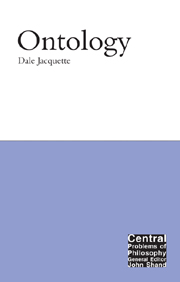Book contents
- Frontmatter
- Contents
- Preface
- Acknowledgements
- Introduction: Being as such
- I Pure philosophical ontology
- II Applied ontology and the metaphysics of science
- 6 Ontological commitment (on Quine)
- 7 Appearance, reality, substance, transcendence
- 8 Physical entities: space, time, matter and causation, physical states of affairs and events, natural laws
- 9 Abstract entities, particular and universal: numbers, sets, properties, qualities, relations, propositions and possibilities, logical, mathematical and metaphysical laws
- 10 Subjectivity of mind in the world of objective physical facts
- 11 God, a divine supernatural mind?
- 12 Ontology of culture: language, art and artefacts
- Conclusion: scientific–philosophical ontology
- Notes
- Bibliography
- Index
6 - Ontological commitment (on Quine)
from II - Applied ontology and the metaphysics of science
- Frontmatter
- Contents
- Preface
- Acknowledgements
- Introduction: Being as such
- I Pure philosophical ontology
- II Applied ontology and the metaphysics of science
- 6 Ontological commitment (on Quine)
- 7 Appearance, reality, substance, transcendence
- 8 Physical entities: space, time, matter and causation, physical states of affairs and events, natural laws
- 9 Abstract entities, particular and universal: numbers, sets, properties, qualities, relations, propositions and possibilities, logical, mathematical and metaphysical laws
- 10 Subjectivity of mind in the world of objective physical facts
- 11 God, a divine supernatural mind?
- 12 Ontology of culture: language, art and artefacts
- Conclusion: scientific–philosophical ontology
- Notes
- Bibliography
- Index
Summary
A syntactical criterion
To be ontologically committed is to accept the existence of an entity or type or kind or category of entities. As individual thinkers we make ontological commitments to the things we believe exist, while theories in the abstract are ontologically committed to whatever entities would need to exist in order for the theories to be true.
The first task of applied ontology is to establish adequate criteria of ontological commitment. Without these we will not be able to certify a preferred existence domain, as an applied ontology must, because we will not be able to distinguish one existence domain from another. We further need such criteria in order to identify the respective ontological commitments of competing scientific theories, especially when theory choice is supposed to be guided by considerations of explanatory economy, and where the search for a preferred existence domain is conditioned at least in part by the choice of a preferred science.
In “On What There Is”, W. V. O. Quine offers a syntactical criterion of ontological commitment. We are required to translate a theory such as Copernicus's astronomy or Darwin's biology into a canonical notation in first-order predicate logic, and then determine the domain of objects corresponding to each quantifier-bound variable in the translation that must exist in order for the propositions of the theory to be true. The idea of Quine's syntactical criterion is to begin with a theory that says, in effect, there are chromosomes or there are unicorns, whose ontological commitments are to be determined.
- Type
- Chapter
- Information
- Ontology , pp. 156 - 181Publisher: Acumen PublishingPrint publication year: 2002



